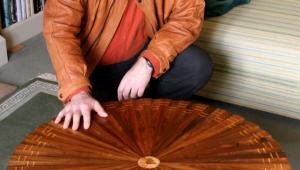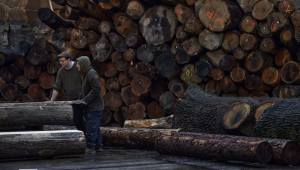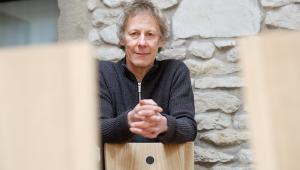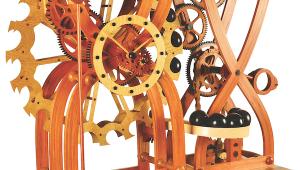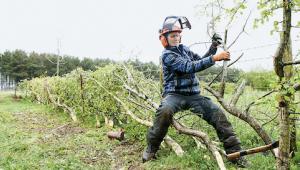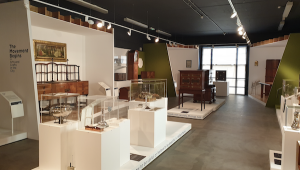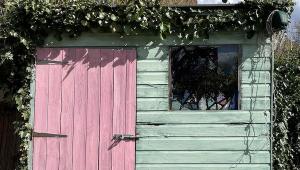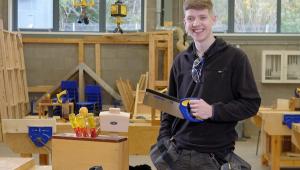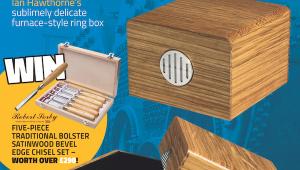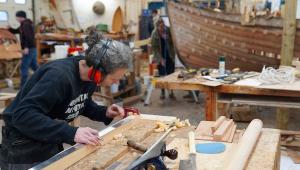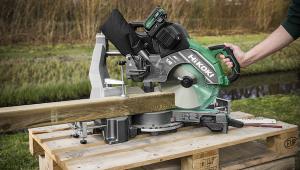Furniture by David Oldfield
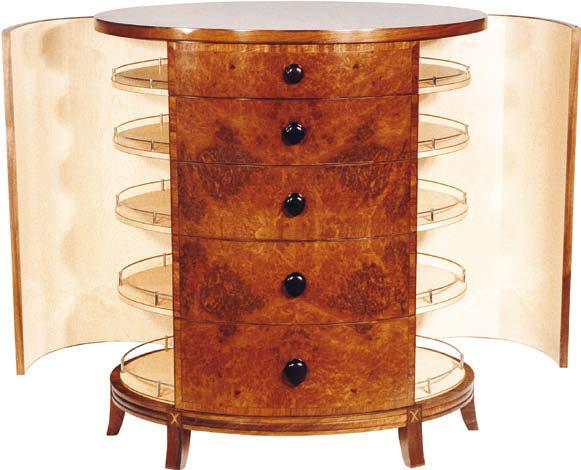
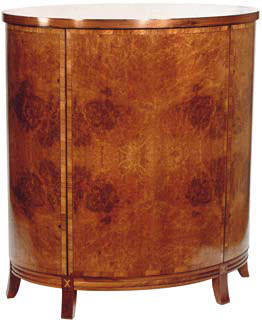
“Lotte, a gentleman’s dressing chest, was one of three pieces built for a wealthy financier – is there any other sort? – at the behest of his wife, who organised his life. For this piece, all she told me was, ‘Steven is quite conservative’ – that was the brief! So I took command because you have to in a situation like that.
“From the point of view of function, a dressing chest calls for drawers and galleried shelves for all those socks, and bow ties, and what have you. Designwise, this piece needed to be severe, simple, and luxurious – it was going into a Regency house in Kensington, after all. I imagined one smooth elliptical casing on a plinth. The timber? Well, something conservative obviously, but also remarkable. Call to veneer merchant: ‘Hello, what have you got?’ Exotic Veneers suggested a Siberian walnut burr that it called ‘Kashmir’. I went to have a look. Brilliant! The leaves, which were large and perfect, and as a four-cut match were about right for the casing, which would open to reveal an interior finished in plain-sawn sycamore, and all based on a substrate of Latvian birch. The finishing touches would come from French walnut cross-banding, rosewood drawer knobs, and silver nickel gallery rails.
“Construction began by chalking an ellipse on the workshop floor, 1000mm on the major axis, 666mm on the minor; the cabinet was to be 1150mm high. Actually building Lotte was very, very difficult because all the components then had to be reduced from the master pattern, which called for some extremely accurate setting out and router work.
“The piece took three months to build, and I called her Lotte because pieces of this calibre take on a persona of their own, and naming somehow draws you closer to them.”
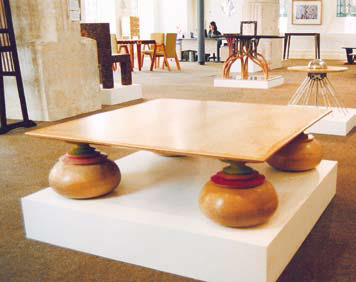
Moonbase One “This piece was made for a gentleman who lived in a small stone cottage. He wanted a coffee table. There wasn’t a brief, and I didn’t tell him what I was going to do. Sometimes, you see, you can use a client’s request as an excuse to engage in what I call ‘pondering’. “What is a table?” I asked myself. A platform on legs. And what can a table look like? It’s that world of ‘if’, again. The commission, then, became an exercise in experimenting with the ways that a table can ‘be’. A marriage, perhaps, of fat and thin, square and round?
“When pondering, I tend to look into blackness and bombard the blackness with shapes. Squashed pumpkins for legs; for the top a kind of thin biscuit. And that’s how Moonbase One came about. Suddenly, I was looking at this object floating in the blackness like a space platform waiting for something to land on it.
“The table top itself was made from plain-sawn sycamore framed with wild English field maple. The legs were made from laminated sycamore, and the shape of the connecting reducing collars was influenced by the insulators on electric pylons.”
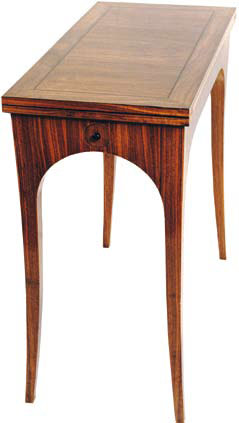
Bertie “With most of my special pieces, I demand carte blanche. Otherwise, I’ve found that I suffer unwelcome interference from the client. However, in the case of Bertie here, who was commissioned by a futures dealer, the brief was for anything, ‘as long as we can play backgammon on it.’ So, a backgammon table it was! The top, I decided, would unfold, swivel 90°, and lock in the playing position. Its frame would be made of walnut with a border and darts of African black walnut and wild English field maple laid into a floor of bubinga.
“For the rest, clean, simple lines were the order of the day: swept legs and grain all running the same way would do away with shoulder lines and make the table appear all of a piece, and give Bertie ‘stance’, or animation if you like.
“David Roberts turned the barrel drawers, shakers and pieces, African black walnut one end, maple the other; the drawer knobs were styled on a shirt collar stud!”
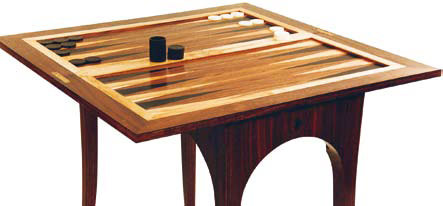
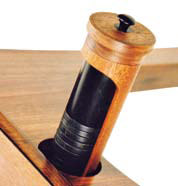
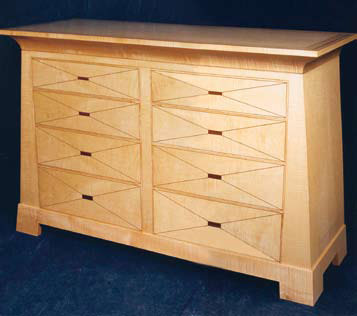
▲ Line and form inspired by ancient
Egypt give these pieces real presence
“I was first invited to Belgravia to meet Robin, a collector of Beidermeier furniture, to discuss making a desk in the same style because she couldn’t find one to buy. As chance would have it, however, by the time of the appointment she’d managed to purchase a desk. Instead, I was shown up to the master bedroom and told, ‘We could do something in here.’ In the style of Beidermeier? I asked. “Not necessarily,’ was the reply. ‘What would you suggest?’ Music to my ears! I looked around to read the tea leaves: everything was expensive and immaculate. I’ll have to think about it, was all I could say. ‘Good. Let me know when you have.’ End of interview.
“Well, I certainly thought about it. In fact, I wracked my brains. Some Beidermeier points to Neo-Classicism, and Neo-Classicism points towards Egypt – well, most things do. What if I donned the mantle of Beidermeier and thought about Egyptian line and form? What you see here is an ode to that frame of mind.
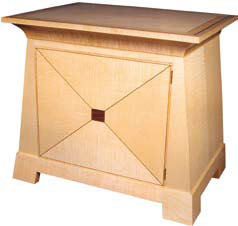
“They’re made from bar ripple sycamore, both solid and veneer, with American walnut inlay. The doors are fitted with touch latches, and open to reveal the inner casings, fitted out with compartmentalised drawers and roll-out shelves. Creating those coved tops on the spindle moulder was a terrifying experience, with the sycamore threatening to tear out at every pass.”
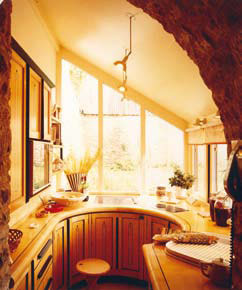
“This commission, for a kitchen that would be part of a converted barn, came via an architectural practise that had, ‘a wealthy client who was as mad as a rat and couldn’t decide what she wanted except that it had to be modern.’ I submitted two designs, which were rejected (‘Love ‘em, couldn’t live with them,’ she said). I declined to submit any more designs, and asked to meet the client, with whom I got on like a house on fire. Mercurial by nature but full of fun and wit, she’d become bored by the pedestrian attitude of the architect.
“I toyed with the idea of the kitchen being circular, but as to the style, well… It was to be part of an old stone barn, so there seemed little hope of modernity, which can in any case be antiseptic. Better, I decided, to go down the charm route but keep it simple. So I drafted an idea, but didn’t give too much away – clients are rarely able to understand or visualise two dimensional drawings – and without much ado she said, ‘OK.’
“I was in seventh heaven, and simply got on with all I’d imagined. Again, the cabinets were built on a carcase of Latvian birch ply and finished with plain-sawn sycamore, with ebony detailing and ebonised handles.
“As always with clients, I let her come at a pre-arranged time to view progress. However, I received no reply to my invitations, and eventually learned from the architect that she was at her studio in Umbria. Now I was worried. This was someone who could easily say, ‘Don’t like that, change it,’ but I was already over halfway through the job. What to do? Hold my breath and carry on? In the end, that was exactly what I did.
“When she returned some weeks later, the kitchen was almost complete. I ‘phoned. ‘Wonderful,’ she said. ‘Can’t wait to see it.’ At the time, my workshop was very long, and on entering it you could see everything. What if she walked in, took a look and rejected it? Worry turned to paranoia. Then I had an idea. The kitchen had been built almost to entirety on a deck at the far end of the workshop from the door, so I built a wall from 8 x 4ft sheets of ply with an offset entrance so that nothing was visible from the door. The surprise was set! As an afterthought, I bought a decent bottle of Madeira.
“She arrived, all smiles, kisses and apologies. I could see she was puzzled: ‘Where’s the kitchen?’ I pointed to the false wall and she disappeared through the door. I remember looking upwards and praying, ‘Please let it be alright.’ Then I heard a little whoop and she was out telling me that she loved it. I could’ve fainted with relief! Out came the Madeira and while I gave her a guided tour of the work we swigged the stuff from tumblers. The bottle didn’t last very long and we became quite daft, laughing drunkenly about the chancer I’d taken.
“The moral? Courage mon brave. When you’re out on a limb, don’t look down!”
- Log in or register to post comments
